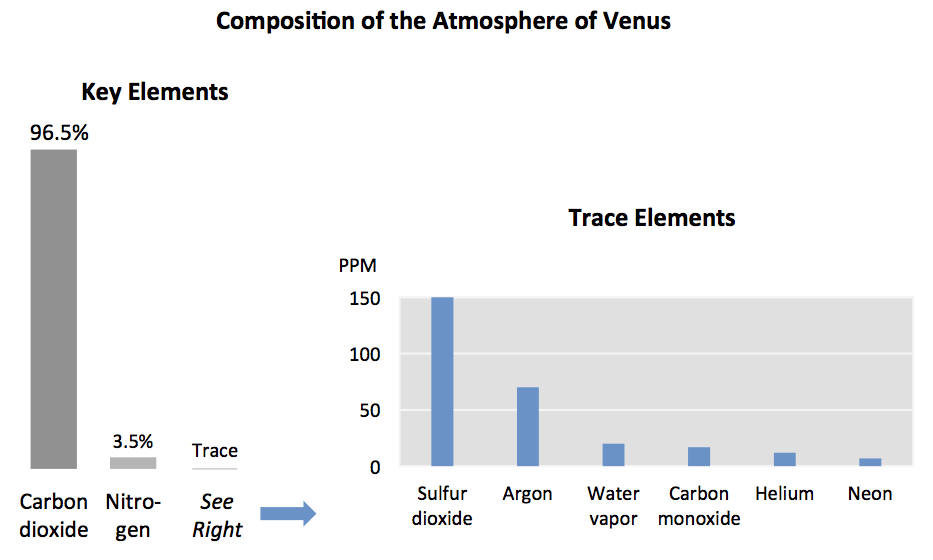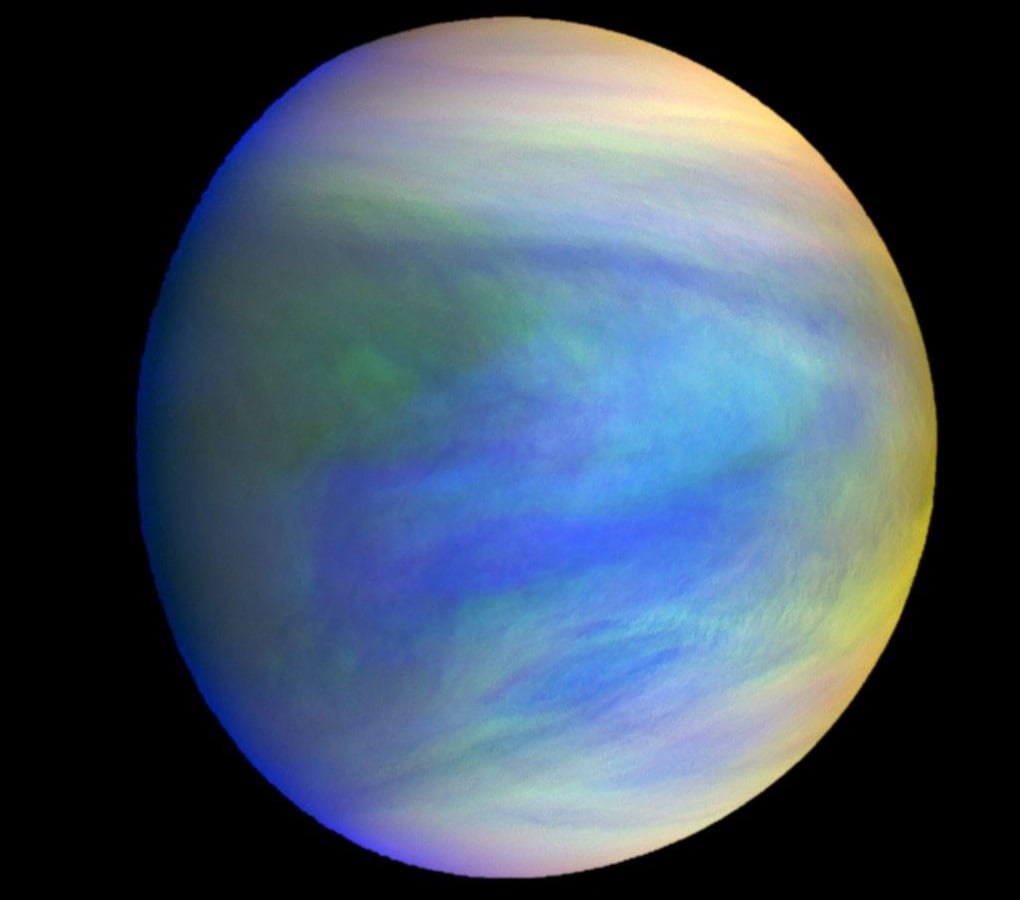When scientists detected phosphine in Venus' atmosphere in 2020, it triggered renewed, animated discussions about Venus and its potential habitability. It would be weird if the detection didn't generate interest since phosphine is a potential biomarker. So people were understandably curious. Unfortunately, further study couldn't confirm its presence.
But even without phosphine, Venus' atmosphere is full of chemical intrigue that hints at biological processes. Is it time to send an astrobiology mission to our hellish sister planet?
While the phosphine discussion petered out pretty quickly, there are other, more long-lived indications that Venus' atmosphere contains chemical anomalies, some of which might relate to life. Some of the atmospheric gases appear to be out of thermodynamic equilibrium, for example. Adding to the complexity, scientists aren't certain what the composition of large particles in the lower atmosphere is.
The authors of a new paper illustrate why Venus captures our chemical curiosity and suggest that it's time for an astrobiological mission to satisfy it.
The paper is " Astrobiological Potential of Venus Atmosphere Chemical Anomalies and Other Unexplained Cloud Properties. " It hasn't been peer-reviewed and published yet, but it's available on the preprint server arxiv.org. The lead author is Janusz Petkowski, an astrobiology researcher in the Department of Earth, Atmospheric and Planetary Sciences at MIT.
"Scientists have been speculating on Venus as a habitable world for over half a century," the authors write, "based on the Earth-like temperature and pressure in Venus' clouds at 48–60 km above the surface."
Most space-interested people know that Venus' atmosphere is extremely dense ant hot. We also know that it's dominated by carbon dioxide, that its other main component is nitrogen, and that it supports dense clouds of sulfuric acid. Other chemicals are present in only tiny, trace amounts.
The atmospheric region between 48 to 60 km above the surface is particularly interesting. At that altitude, both the pressure and the temperature approach near Earth-like levels. Between about 52.5 km and 54 km, the temperature is between 20 °C and 37 °C.) At about 49.5 km above the surface, the pressure is the same as at Earth's sea level. There's no way that liquid water could be present on Venus' surface, but in the atmosphere it's possible.
That's the backdrop for considering Venus' potential habitability.
But there are ample chemical considerations, too, and in their paper, the authors outline one long-standing mystery in the planet's atmosphere.
"In this paper, we review and summarize Venus' long-lasting, unexplained atmospheric observations,
which have been acquired over the span of the last half-century," they write.
A lot of the mystery around Venus concerns the so-called "unknown absorber(s)." As far back as the 1920s, ultraviolet observations showed unusual high-contrast features that move in conjunction with Venus' upper cloud deck's four-day rotation. Something is absorbing the UV light. "Much effort has gone into attempting to identify the substance(s) responsible for the absorption between 320–400 nm, but no proposed candidate satisfies all of the observational constraints, leading to the oft-used descriptive term 'unknown UV absorber,'" the authors write.
Researchers have made a prolonged effort to understand what the absorber or absorbers might be, and some have made progress. Research has shown that sulphur allotropes and sulphur compounds could be responsible, and researchers have uncovered new pathways for their formation in Venus' atmosphere. But these pathways are the result of simulations, not exploration. Not everyone agrees with these findings. There's no consensus.
"Despite decades of effort and observations by two orbiting spacecraft in the 21st century (Venus Express
by ESA and Akatsuki by JAXA), none of the proposed candidate molecules have been found to entirely fit
the observational data," the authors explain. The candidates either don't match the profile well, or they're not abundant enough. Some of the proposed candidates aren't stable, either.
But it's critical that we figure out what it is. "The unknown absorber is remarkably efficient, capturing more than 50% of the solar energy reaching Venus, with consequent effects on atmospheric structure and dynamics," write the authors. Though the mystery persists, it's a huge missing piece that stymies our efforts to understand the planet.
Some researchers propose that the UV absorber is a sign of cloud-based biological activity. "The spectral characteristics of the Venus clouds, including the strong UV absorption, are consistent with the spectrum of certain types of terrestrial bacteria," the authors explain.
Another of the mysteries concerns lower clouds. A subset of cloud particles larger than 7 µm is unknown. Adding to the mystery is that some of them aren't round. We know this from NASA's Pioneer Venus mission. Since the particles, called Mode 3 particles, are non-spherical, they can't be liquid droplets. "The nature and composition of the Mode 3 particles is debated with data presently in hand," the authors write, making it clear that we need more data from a modern mission.
Some have proposed that the particles could be sulfuric acid, but the authors say data rules that out. If they're not sulfuric acid, that works in favour of the idea that life could persist in the clouds. "This result could indicate unknown chemistry and is intriguing with regard to the possible presence of 'life as we know it,' which cannot withstand a concentrated sulfuric acid environment," the authors explain.
It should be noted, however, that not all scientists agree that the large particles even exist and that calibration errors could be responsible for their detection instead.
The authors outline other reasons why only a biological mission to Venus can solve these mysteries. In-situ measurements from the Venera program and the VeGa balloons suggested that the atmosphere hosted non-volatile compounds necessary for life. Life as we know it requires metals, including iron. Venera found iron, while VeGa didn't. More mystery waiting to be solved.
There are other unexplained components in Venus' atmosphere. There are trace gases with abundance profiles that scientists can't explain. Venera and Pioneer also found oxygen there. Nobody knows where it came from, and it's a subject of frequent discussion. Other chemical detections add to the mystery and complexity.
The maddening thing about studying Venus from afar is that many of the observations could be explained by either biotic or abiotic processes. That's why we need a biological mission.
"The habitability of the Venusian clouds should also be explored by new in situ missions," the author explains. Lots of scientists agree with them, including renowned planetary scientist Sara Seager. In fact, Seager goes even further, suggesting that a sample-return mission is needed.
There are missions to Venus coming in the future. NASA's VERITAS mission and DAVINCI mission will both head to Venus, but not for several more years. DAVINCI will send a probe into Venus's atmosphere for in situ observations, while VERITAS will map the surface in more detail.
In the meantime, the data we have is all the data scientists have to work with. While scientists are resourceful and determined, that's not enough.
Only a mission to Venus that's solely focused on biology and chemistry can solve the planet's mysteries.
 Universe Today
Universe Today



